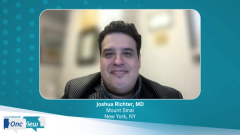
Selinexor, Carfilzomib and Dexamethasone (XKd) in Triple-Class Refractory MM
An overview of recent data on selinexor, carfilzomib, and dexamethasone in triple-class refractory multiple myeloma, and treatment options to replace belantamab.
Episodes in this series

Transcript:
Joshua Richter, MD: Although there’s a variety of heterogeneity in the way patients receive therapy in the United States for myeloma, we can look at the most common pathway people take. Despite the multitude of options in the upfront setting, the most commonly prescribed option at the moment of this recording is VRd, Velcade [bortezomib], Revlimid [lenalidomide], and dexamethasone. Regarding second-line therapies, there’s even more heterogeneity, however at the time of this recording, the most commonly prescribed regimen in the United States is daratumumab, pomalidomide, and dexamethasone. That leaves us in the next line of therapy saying we want to use a drug like carfilzomib, which has been traditionally one of the therapies we used in early relapse. However, the question is, what do we combine it with? We can give it as a Kd [carfilzomib, dexamethasone] doublet, however we recognize through the last decade or more of studies that triplets are better than doublets. We can combine carfilzomib with cyclophosphamide and dexamethasone, but cyclophosphamide is half a myeloma drug at best.
However, [Gary] Schiller, [MD,] and colleagues presented some of their data looking at XKd, the combination of selinexor, or Xpovio, carfilzomib, and dexamethasone. They were specifically looking at this in patients who [were] either triple-class refractory, or had triple-class treated myeloma, patients who’d had all these other lines of therapy. Overall, as we discussed previously from the MAMMOTH study and the Flatiron [Health] study, these patients traditionally had poor outcomes, with penta-refractory having a median overall survival of around 5.6 months. However, in this study with Schiller, he showed that patients had a significantly high response rate of around 66.7%, and a median progression-free survival of 13.8 months, with a median overall survival of 33 months. So in general, we’re looking at patients who’ve now been exposed to and refractory to multiple classes of agents, and they were able to have a significant number of them respond and have durable responses, as well.
In general, this was a fairly well tolerated regimen. Although we see some AEs [adverse events] across the board, the regimen is well tolerated overall. The major AEs we look for in a regimen like this are cytopenias because this is a hematologic malignancy. Overall, the major worries we see with things such as cardiac events were extremely minimal in this study. What this study brought about is that for patients in the third or fourth line [or beyond] who are carfilzomib naive, this represents an excellent treatment option for them.
For anyone who was either suitable for belantamab or previously on belantamab prior to its removal from approval by the FDA, you can use selinexor or CAR [chimeric antigen receptor] T-cell therapy. If they are progressing on belantamab or just had belantamab, we’re still trying to figure out what it looks like when you progress on one BCMA-based therapy and you go on to another BCMA-based therapy. There are some conflicting data out there. Some studies show that it does not impact outcomes. However, some have shown that if you are progressing on a BCMA therapy, you will have worse outcomes if you go onto another BCMA therapy. We’re still trying to figure that one out.
In general, if you’re progressing on a BCMA-based therapy, going to another mechanism of action in the middle may be of some advantage, and this may allow BCMA to either repopulate, or enhance efficacy of another BCMA therapy later. Again, we don’t know this just yet, and the reality is that all the options are available. You can go from belantamab to a CAR T to selinexor, or go from belantamab to selinexor to a CAR T. We know that selinexor doesn’t seem to impair the ability to collect CAR T cells, so both versions would be applicable.
Transcript edited for clarity.
Newsletter
Stay up to date on recent advances in the multidisciplinary approach to cancer.

































































































